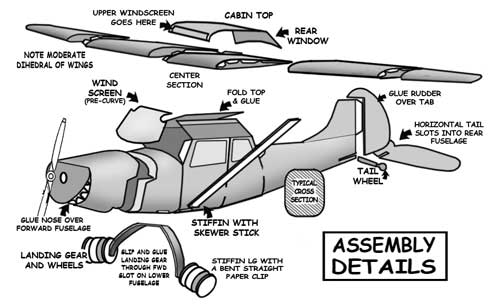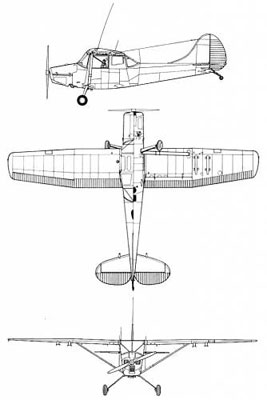
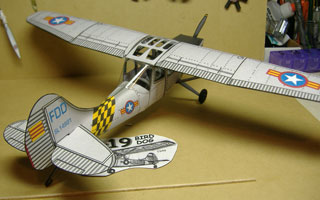
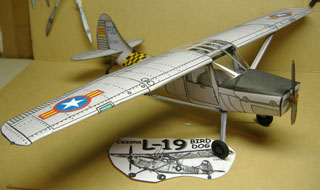

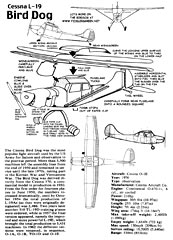
Cessna-BirdDog - $$4.95
The Cessna L-19/O-1 Bird Dog is a liaison and observation aircraft. It was the first all metal fixed wing aircraft ordered for and by the United States Army since becoming its own branch of service, U.S. Air Force. The Bird Dog had a lengthy career in the U.S. military as well as in other countries. This model is also available as a large collection of 12 versions as of 9/09.
General Eisenhower's Personal Cessna L-19 Birddog
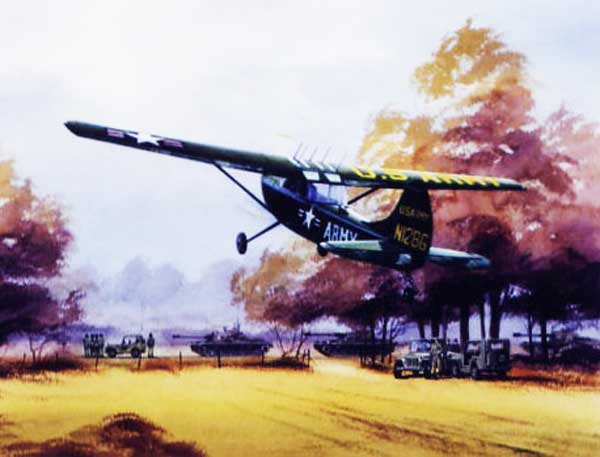
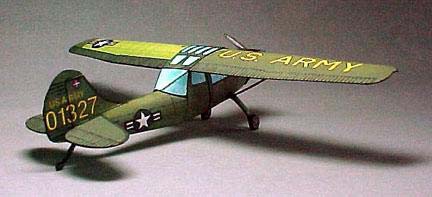
The Cessna Bird Dog was used extensively in Korea and Vietnam as an observation airplane. Note the five star markings on the nose. This little model is of the Bird Dog that Ike used to keep his campaign promise to inspect Korea.
The Cessna L-19 Bird Dog was the most popular light aircraft used by the US Army for liaison and observation in the postwar period. More than 3,500 machines left the assembly lines from the end of 1950 and remained in service until the late 1970s, taking part in the Korean War and Vietnamese War.
This webpage is for the single Cessna Bird Dog, the Cessna Bird Dog Collection which has 12 different versions as of December, 09
Click HERE to get to the Cessna Bird Dog Collection model offer
(the pages will be similar)
Thanks so much for the O1E. Back in '67 I occasionally was a back-seat bombardier out of Khe Sanh. A certain Air Force LTC (who shall remain classified) and I (who was US Army Green Beret) would fly out over the boonies and drop mason jars with grenades in them over selected sites on the Ho Chi Minh Trail. The Colonel would shoot rockets & I would drop bottles. One time we got a secondary explosion that sent a mushroom cloud up to about 4,000 feet. We always debated, over libations, whether it was his rocket or my bottle that caused the big blast. I regrettably had to concede to his rockets. Anyway, for a while we were a scourge along the Ho Chi Minh Trail....Dave D
Nice Birddog, but one small error. All the FAC machines, the 0-1, 0-2, OV-10 were painted white all over, as white as this page. That way we could see them easily against the green jungle. The only ones that were not white were the Fireflies, which were actually Sandy's, A-1E's, and they as well as all the Fast FACS were the standard paint for the particular aircraft, such as the Navy and Marines were gray, and the AF were camouflage.
Some of the slow FAC aircraft had no markings, such as some
that worked in Laos, and later Cambodia, 0-1's and 0-2's.
Many of the earlier ones even had changeable insignia, depending
who Air America (who flew them) represented that particular
day. There were actually slots on the side of the airplane
that they would slide the insignia in. Given all that blather,
White for the 0-1.
I'm doing the F-4E at the moment, and it is a challenge.
Oh, those compounded curves! I plan to put it behind a Mig
21. Right where I always wanted to be with my F-4! Great
stuff! Keep it up! Bob H
Nice to get this model. I work at Cessna and knew the guy who came up with the "Bird Dog" nickname. Also, my husband was crew chief on one at Fort Lewis, Washington in his younger days. Barbara
Chip, thanx for encouraging me to pursue the Bird Dog interior. My first attempt at this was just to see which way I needed to go with it... like discovering how the wood or stone wants to be chiseled. My second attempt took me farther...but fell to the floor one day, a dark green airplane on dark green carpet, and the gremlins managed to get it under my foot before I realized it. Crushed flat, it was fate that redirected me to a more successful third attempt which is very promising. I spend a long time, days even, looking at what I have managed so far, comparing photos of a real Bird Dog being restored. Hmmmm....it is coming together better than I had originally hoped. Sometimes things progress in an agonizingly slow manner. Sometimes things seem to go together on their own, held back only by slow handling of the knife and glue...like children running ahead at the zoo, full of excitement, and me, the old man, hardly keeping up. As though the project takes on a life of its own. Part of my slowness is that I just like to savor each little success. But, hey, that is what this hobby is about. Larry R (3/6/02)
My name is Dave Brodigan and I was an Army aviator in Vietnam. I was a FAC with the 219th Avn. Co. in Pleiku. We were the Headhunters. The info you supply with your birddog says that fixed wing FAC duties were turned over to the Air Force in 1965. This is not true. The Headhunters were in Nam from 1965 to 1972. No big deal, it's just that when you think of aviation in Vietnam everyone naturally thinks of helicopters. There weren't that many Army fixed wing pilots so we try to stick up for our selves when ever we can....
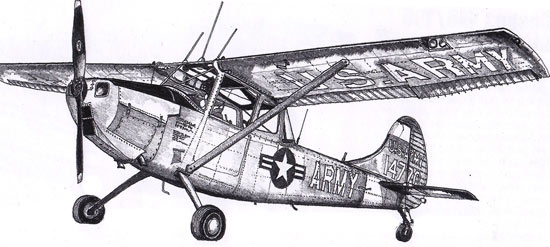
The L-19 Bird Dog is the most modern L-bird, if you consider an airplane designed 50 years ago modern. Its all-aluminum structure is pure Cessna 170, with a specially designed fuselage that benefited from everything the designers learned during World War II. When the Korean War came along, the L-19 earned its combat spurs and was still performing legendary duty as a FAC through most of the Vietnam War. In its clandestine guise as a Raven, the airplane wrote many cloudy historical chapters.
With a 213 hp, derated 0-470 Continental, the Bird Dog really gets with the program on takeoff, but figure only about 115 mph in cruise. With Cessna's wonderful slotted Fowler flaps that come down to a whopping 60 degrees, it'll drop over a tree line like a rock to work short fields like a rocket ship. In fact, a full-flap landing is a test to see if the pilot knows exactly where the ground is and how fast he or she can flare.
|

The airplane sits really high with terrific visibility and carries its two occupants in a cockpit that's much larger than necessary, which gives lots of Spartan comfort. Its ground handling is typical of all spring-gear Cessnas and requires just a little more attention than some of the older L-birds.
The good news is there are plenty of L-19s (also called O-1s) available. The bad news is (hey aren't cheap. Figure 550,000 to get into the game and 565,000 to get a decent one. Warbirds of any kind are caught up in a fantastically rapid upward price spiral and, while the L-birds are also increasing rapidly, they haven't yet gone out of sight. For a pilot wanting a good flying, interesting piece of aeronautical history, the L-bird market offers something for everybody. Whatever your budget, there's an olive drab miniwarbird out there that can fit it.
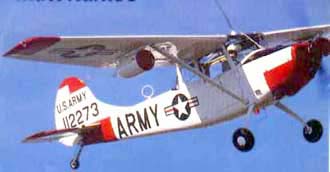 When shopping for L-birds, however, don't forget the pilots.
L-bird pilots have been largely forgotten, and it's time we remember
that it was the pilots, many of whom weren't officers, who wrote
our history, not the airplanes.
When shopping for L-birds, however, don't forget the pilots.
L-bird pilots have been largely forgotten, and it's time we remember
that it was the pilots, many of whom weren't officers, who wrote
our history, not the airplanes.
They went to war the hard way, with nothing more than 65 hp, a radio and a map. With the exception of a 0.45 on their hip and the occasional M-1 carbine or Thompson, they were unarmed. Still, from World War II until present day, the Liaison/FAC (Forward Air Control) pilots and their Pipers and Cessnas have been among the most feared aircraft in the air.
As the enemy in Vietnam learned, once the FAC located its target, it could bring a formidable, virtually unlimited arsenal to bear. From rolling artillery barrages to waves of Phantoms and Thuds storming over the ridges, all the FAC had to say was "Hit my smoke," and a carpet of destruction would descend upon the enemy position.
The story of the FAI: pilots of Vietnam and the liaison/artillery spotters of World War II and Korea is a chapter of history that's mostly hidden in the larger shadow cast by the more glamorous warbirds.
Fighters and bombers, the so-called "real" combat aircraft,
get all the glory. The Grasshoppers and Bird Dogs, however, got
the job done and deserve more credit than they've received. Today,
they represent one of the most affordable and fun ways to get
into the warbird game.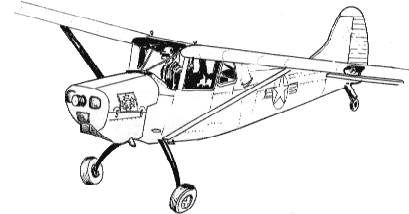
The littlest warbirds are grouped into two historical categories: World War II and post-World War II. The World War II Grasshoppers came in a wide variety, while those that came after the war are primarily represented by only a few types, with the L-19 Bird Dog being the most numerous.
Within both groups there are aircraft that, while occasionally available, range from rare to almost nonexistent. There are also a few airplanes, such as the L-17 Navion or L-126 Cessna 195, which, although not combat birds, still qualify as warbirds and offer tremendous utility to boot.
The subject of Liaison aircraft is a world unto its own but, fortunately, much of the aircraft information, both technical and historical, is available through the International Liaison Pilot and Aircraft Association (16518 Ledgestone, San Antonio, TX 78232).
L-birds were produced in the thousands-in some cases, in the many thousands 30 even though time and the elements have destroyed many, they still exist in large numbers. A few years back, they could be found slouching in the grass on back tiedown lines in disreputable condition.
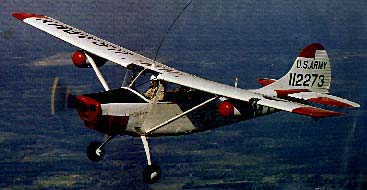 This
has changed as more pilots not only recognize their historical
significance, but also recognize what fun flying machines they
can be. Today, hundreds have been or are being restored. Fortunately,
they continue to reappear out of the shadows of forgotten bams
and hangars at ridiculously low prices.
This
has changed as more pilots not only recognize their historical
significance, but also recognize what fun flying machines they
can be. Today, hundreds have been or are being restored. Fortunately,
they continue to reappear out of the shadows of forgotten bams
and hangars at ridiculously low prices.
CESSNA OE-2
Developed to meet a specific Marine Corps requirement, the Cessna Model 321 was similar to the OE-l /L-19 series, but used Model 180 wings, a new fuselage and a 260 hp Continental 0-470-2 engine. A batch of 25 went to the Marines as OE-2s in 1955 and two in 1956, but the higher cost of this model prevented its adoption on a wider scale. The designation changed to O-1C in 1962.
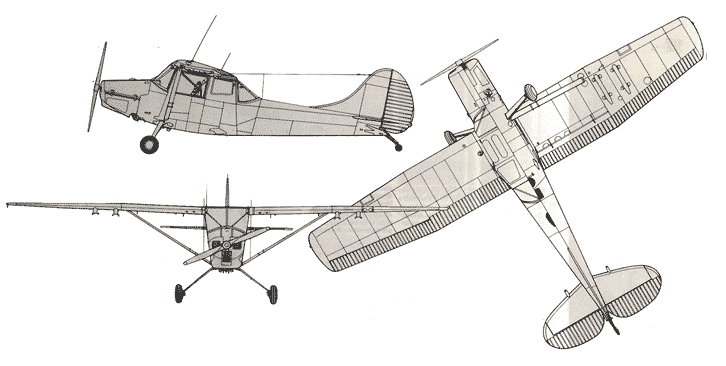
Cessna O-1
Few aircraft were as important for the efficient conduct of war operations in Vietnam as the small, unarmed Cessna O-1 B, previously known as the L-19. Spearhead of the FAC (Forward Air Control), it formed part of the US Army organization until 1965, when all fixed-wing observation aircraft were turned over to the USAF. Flying at low level and reduced speed, their duty was to discover objectives, for the most part concealed in the jungle, such as groups of guerillas, convoys traveling along the Ho Chi Mm Trail, or enemy units lying in ambush for unsuspecting government troops.
Having spotted the enemy, they would immediately radio the DASC (Direct Air Support Center) which, as a rule, would be able to get attack aircraft to the spot within half an hour. The latter were again guided by the Bird Dog pilots who, in addition to pinpointing the objective with smoke or magnesium flares, would check the effectiveness of the strikes, if necessary correcting the aim. However, the O-1 s were an easy target for the enemy, who could often hit them with ordinary rifle fire, without recourse to heavy anti-aircraft fire. Many Bird Dog pilots lost their life while carrying out their duty; they were usually officers with years of experience, veterans of many battles. Among the finest fighters, they succeeded in converting their little unarmed planes into formidable offensive weapons.
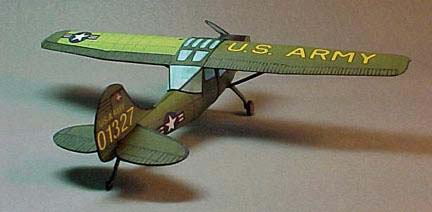 This great lookin' L-19 was sent to us by MP Anthony Sanchez. |
NOTE: Got an Email from a modeler who says the wings are wrong on
the Bird Dog model. Checked it again, and the colors of this
very unique light plane of General Eisenhower's DID have wings
with the alternate light green coloring shown on the model. |
TAYLORCRAFT (reference)
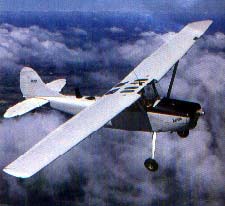 A lot of general aviation has forgotten Taylorcraft ever built
a tandem model because the BC-12 side-by-side model was so tremendously
successful. However, prior to the war, the company built the Model
D, most of which originally went to the Civilian Pilot Training
(CPT) program. As with most of the other Liaison aircraft, when
it was drafted into the military, one of the first things the
military did was put as much glass in the airplane as possible.
The glass was unique on the L-2 because, rather than just running
windows around the existing fuselage as on the other kbirds, the
rear fuselage line was lowered and a formed, Plexiglas section
was installed, which completed the step from the wing down to
the fuselage.
A lot of general aviation has forgotten Taylorcraft ever built
a tandem model because the BC-12 side-by-side model was so tremendously
successful. However, prior to the war, the company built the Model
D, most of which originally went to the Civilian Pilot Training
(CPT) program. As with most of the other Liaison aircraft, when
it was drafted into the military, one of the first things the
military did was put as much glass in the airplane as possible.
The glass was unique on the L-2 because, rather than just running
windows around the existing fuselage as on the other kbirds, the
rear fuselage line was lowered and a formed, Plexiglas section
was installed, which completed the step from the wing down to
the fuselage.
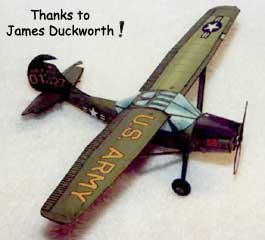 Most military adaptations of civilian airplanes worked to reduce
the use of war-critical materials, so the wings of the L-2 were
made entirely of wood, rather than using pressed aluminum ribs
as on the BC-series Taylorcrafts. Since no one ever thought they'd
be flying a half-century later, there wasn't that much thought
given to longevity during their production. Also, in the passing
years, almost all of the less popular L-birds, such as the L-2,
spent part of their lives collecting mice and birds' nests as
the local airport derelicts.
Most military adaptations of civilian airplanes worked to reduce
the use of war-critical materials, so the wings of the L-2 were
made entirely of wood, rather than using pressed aluminum ribs
as on the BC-series Taylorcrafts. Since no one ever thought they'd
be flying a half-century later, there wasn't that much thought
given to longevity during their production. Also, in the passing
years, almost all of the less popular L-birds, such as the L-2,
spent part of their lives collecting mice and birds' nests as
the local airport derelicts.
So, if you're thinking about a wooden wing L-bird, inspect it carefully for wood and glue joint deterioration. Also, check the fuselage tubing for rust, as 50 years is a long time and rust never sleeps. The usual engine was the Continental A-65, and the airplane isn't light (815 pounds-100 pounds more than a stock Cub), so it doesn't exactly rocket off the ground.
The airplane is like most other L-birds in that it's the soul of docility. However, it also uses the semi-symmetrical wing of all other Taylorcrafts, so it's (marginally) faster than the rest, but the others can often out climb it. It can also be a real floater if brought in fast. Its tendency to float prompted the military to put spoilers on the L-2M. Unfortunately, the FAA has said the spoilers have to be deactivated on certain airplanes.
Perfect for its job, the L-19 was not only a rugged design, but was also a good short-field performer. About 3400 Cessna L-19's were produced and many of them were sold as surplus after they completed their military tours. A few may still be found in commercial service on bush duty in Alaska or as glider tugs in the "lower forty-eight". The Cessna Bird Dog was one of the last liaison airplanes in regular service, before helicopters virtually eliminated the need for this type of aircraft in combat. |
Another plus is all-metal construction, which is important for straight floats (as opposed to amphibious floats), as it is frequently difficult to hangar a floatplane. There are small vertical fins installed on the horizontal stabilizers of the L-19 floatplanes, which make up for the vertical area that floats add to the forward area of the airplane. This is a common part of the float conversion on many lightplanes. There are a good number of L-19's flying, so it would not be too surprising if the population of floatplane examples increases in the future. |
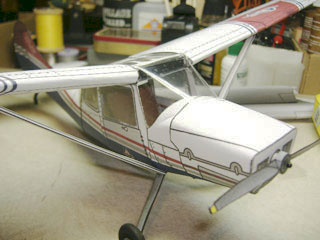 |
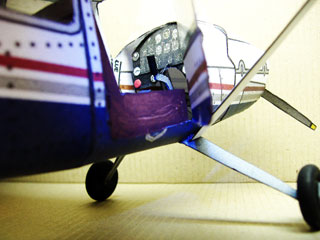 |
Clear Cabin Cessna Bird Dog Bob Martin sent in these wonderful images of a Thanks Bob! |
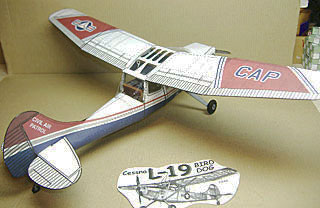 |
 |
 Vietnam L-19 Bird Dog Submitted by Bob Martin Thanks Bob! |
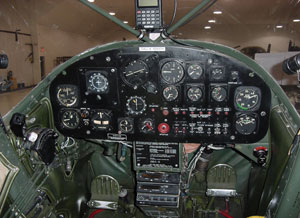 |
Cockpit of the Cessna O-1A(L-19) Bird Dog. |
Specifications for the Cessna O-1a (L-19) Bird Dog
|
Crew: 2 Length: 25 ft 9 in Wingspan: 36 ft Height: 7ft 3½ in Wing area: 174 ft² Empty weight: 1,614 lb Max takeoff weight: 2,400 lb Powerplant: 1× Continental O-470-11 flat six piston, 213 hp Performance Maximum speed: 130 mph Range: 530 miles Service ceiling: 20,300 ft Rate of climb: 1,040 ft/min |
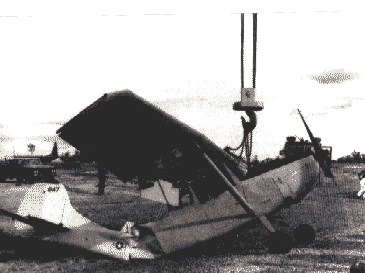



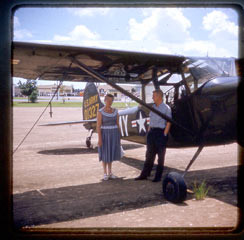
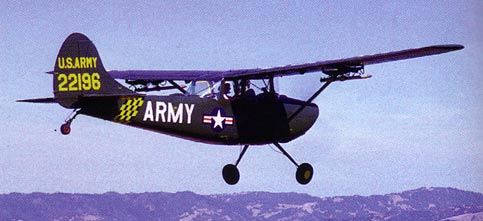 The L-19 "Bird Dog" was the backbone of the
United States Army liaison and observation squadrons throughout
the 1950's and early 1960's. It was used in both the Korean
and the Vietnam Wars. Frequently employed as a Forward
Air Controller (FAC), the L-19's duty was to direct artillery
fire and to launch smoke rockets, marking targets for
the larger and faster ground-attack aircraft. That meant
spending long periods of time flying at low altitudes
over the front lines.
The L-19 "Bird Dog" was the backbone of the
United States Army liaison and observation squadrons throughout
the 1950's and early 1960's. It was used in both the Korean
and the Vietnam Wars. Frequently employed as a Forward
Air Controller (FAC), the L-19's duty was to direct artillery
fire and to launch smoke rockets, marking targets for
the larger and faster ground-attack aircraft. That meant
spending long periods of time flying at low altitudes
over the front lines. 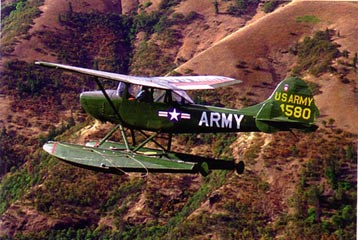 There are several float equipped examples of the Cessna
L-19 (operated both as sportsman's airplanes and as commercial
charter airplanes) flying today. The type is ideally suited
for float operations. It features an excellent power-to-weight
ratio, great visibility, high performance short field
take off and landing characteristics, and rugged construction,
which are all valuable assets in the floatplane field.
There are several float equipped examples of the Cessna
L-19 (operated both as sportsman's airplanes and as commercial
charter airplanes) flying today. The type is ideally suited
for float operations. It features an excellent power-to-weight
ratio, great visibility, high performance short field
take off and landing characteristics, and rugged construction,
which are all valuable assets in the floatplane field. 